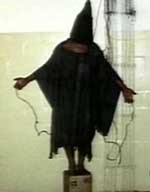 Army Says Better Training Could Have Prevented Abuse
Army Says Better Training Could Have Prevented Abuse
By Richard A. Serrano, Times Staff Writer
WASHINGTON — Army officers in Iraq told their superiors last year that soldiers often lacked the training to handle detainees, did not always understand what constituted abuse, and sometimes used techniques against prisoners that they “remembered from movies,” according to military records made public today.
Soldiers shot and killed some detainees who had been bound, according to the documents. In one case, officers said the slaying could have been prevented if the soldier “had better training” and understood Army rules.
Army lawyers determined that another fatal shooting of a prisoner allegedly trying to escape could have been avoided “with better facilities, and training of the guard force.”
The documents were among the 1,800 pages released today by the American Civil Liberties Union as part of its New York-based lawsuit to learn more about prisoner treatment.
The episodes were described last year to Lt. Gen. Paul T. Mikolashek, the Army inspector general who reviewed detainee abuse arising out of the torture scandal at the Abu Ghraib prison near Baghdad.
In releasing his findings in July 2004, the general determined that there were no “systemic failures” or widespread detainee abuse.
But according to documents, Mikolashek was told of numerous incidents in which poor training and inadequate facilities created an atmosphere that fostered abuse.
Paul Boyce, an Army spokesman, said the documents were “Army reports and Army information where the Army was looking into allegations and sorting out the situation about detainee mistreatment.” But he said they did not show widespread abuse.
“The Army has looked carefully at each allegation and addressed it very thoroughly,” he said.
He added that more than 400 investigations have been done since the Army began reviewing Iraqi prisoner mistreatment at Abu Ghraib in January 2004. He said that allegations against more than 200 soldiers have led to courts-martial, non-judicial punishments and other administrative penalties.
Mikolashek’s report described Iraq as an “intense operational environment” and said the “Army’s leaders and soldiers are effectively” carrying out detainee operations. Based on his inspection, he said, “we were unable to identify systemic failures that resulted in incidents of abuse.”
Anthony D. Romero, executive director of the ACLU, said the new documents suggested that Mikolashek brushed aside evidence that there was abuse and significant training problems.
“Our government has failed and the blame is on Washington, not Hollywood,” Romero said.
He was referring to an account in one of the documents in which a platoon leader with the 4th Infantry Division from Ft. Hood, Texas, said interpreters were often taken along on raids to pick up insurgents. But there often were not enough interrogators to go with the interpreters, and that meant other officers were thrust into jobs interviewing detainees even though they had no training in that field.
“Officers and NCOs (non-commissioned officers) at point of capture engaged in interrogations using techniques they literally remembered from movies,” the platoon leader said.
He added: “Soldiers need to be trained in basic tactical interrogation techniques. It’s going to be done one way or the other. Why not the right way?”
In another report to Mikolashek, an officer said a soldier “killed a detainee he was guarding” at a collection point before the prisoner could be sent to a prison.
“The detainee’s hands were tied and between the (holding) wire and the soldier shot and killed the detainee,” the officer said. “This incident could have been prevented if he had better training.”
He said the soldier did not understand the rules of engagement, and noted that the soldier was “chaptered out of the service.”
In a second incident, a member of the Judge Advocate General’s office from the 4th Infantry Division described a guard who shot and killed a prisoner he believed was trying to escape. He said the detainee’s hands were flexi-cuffed, and he was standing behind the wire.
“The investigating officer determined the detainee was not trying to escape,” the JAG officer said. “He said the incident could have been prevented with better facilities, and training for the guard force.”
It was unclear whether the guard was punished.
In other instances, two officers reported a detainee was forced to sit on the floor while a bottle of water was poured over his head by a civilian interrogator working for the United States.
The detainee “had problems breathing,” the documents said. “He yelled during the process.” Apparently the civilian interrogator was “not the one to do this,” and he “just seemed to be having a good time because (the) detainee was not talking and never did talk.”
The incident was not reported to superiors because “it was not seen as a violation.”
A staff sergeant complained that every day there was “no guidance” on what soldiers were allowed to do, that there was “no definition on specific rules.”
Similarly, a sergeant described a detainee being forced to lie on his back and raise his feet in a “chair position” against a wall, and then “made to do squats.”
“Again,” the documents said, “this incident was not reported. When asked why, the sergeant replied that it was because they ‘didn’t know what was abuse,’ and that ‘prior to this incident (the chain of command) had never talked about what is abuse!'”
ATTENTION READERS
We See The World From All Sides and Want YOU To Be Fully InformedIn fact, intentional disinformation is a disgraceful scourge in media today. So to assuage any possible errant incorrect information posted herein, we strongly encourage you to seek corroboration from other non-VT sources before forming an educated opinion.
About VT - Policies & Disclosures - Comment Policy



